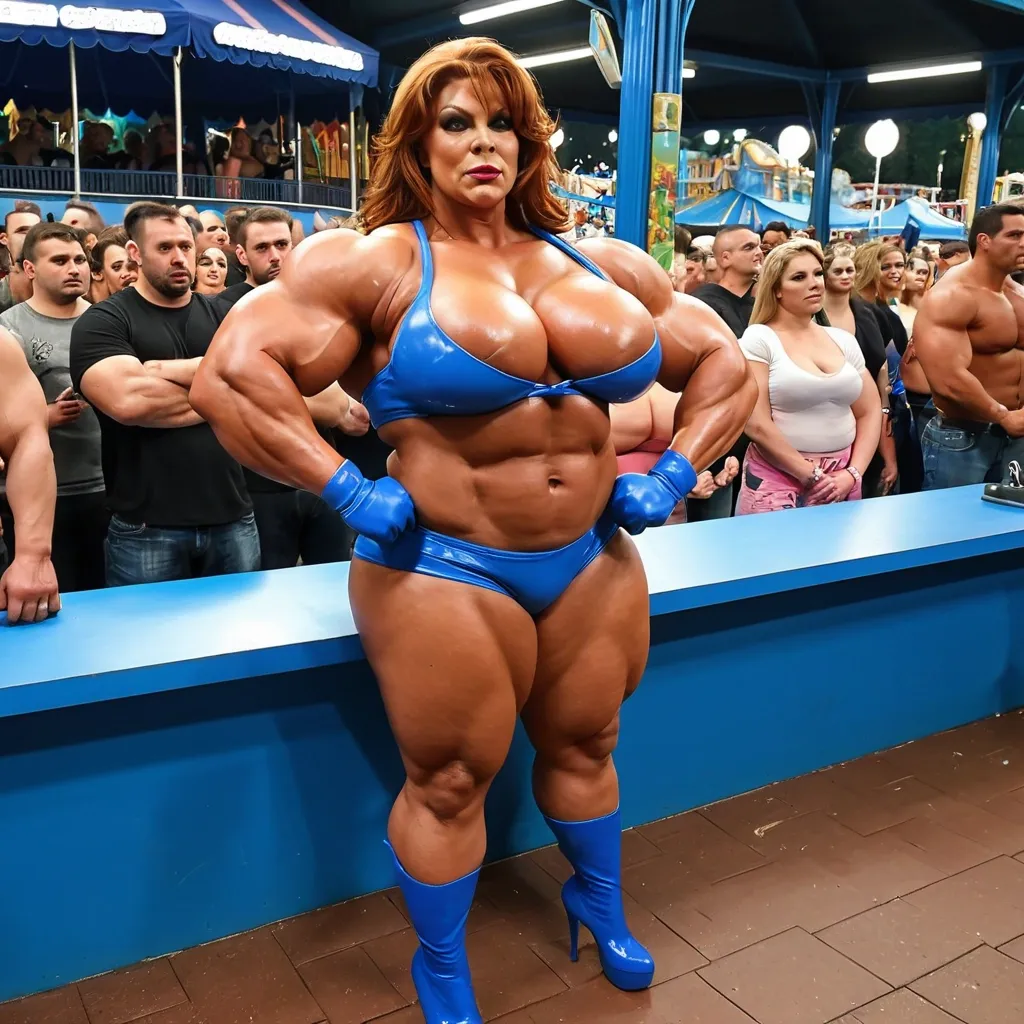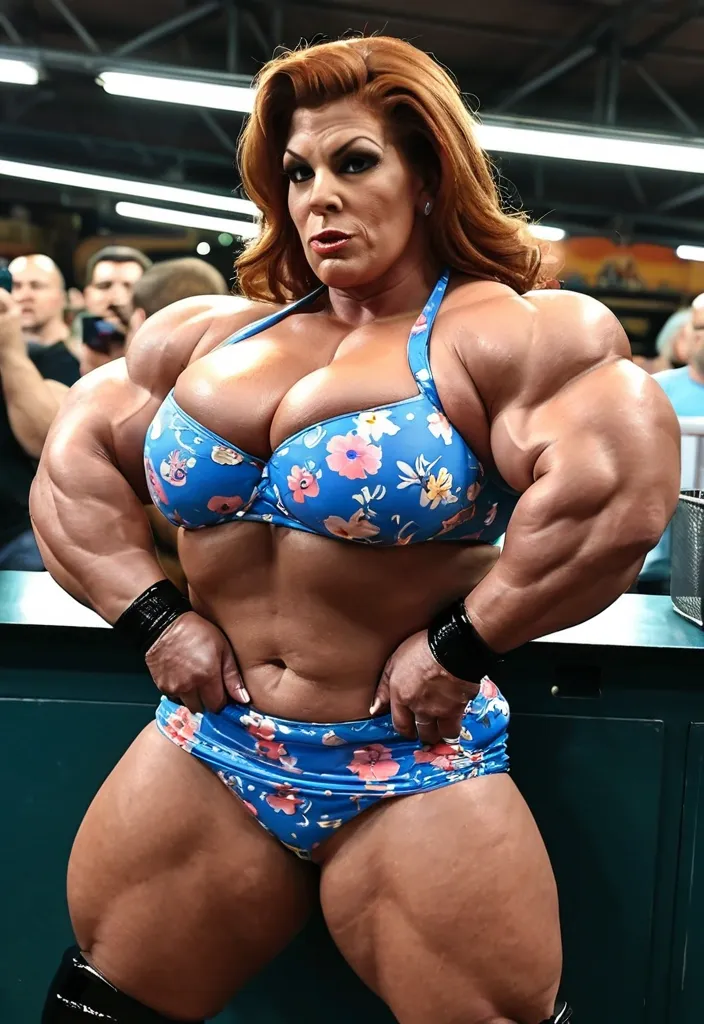Search Results for counter
Explore AI generated designs, images, art and prompts by top community artists and designers.

L-shaped kitchen unit: Glossy Wine-Burgundy lower cabinets , Matte muted Terracotta upper cabinets extending to ceiling. Dark quartz countertop. Gold mosaic backsplash reflecting light. No kitchen island. Compact dining table with Indigo velvet chairs , brass legs. Visual separation: Low open shelving unit (matte black) between zones. Living room: Dusty Rose walls , Emerald Green accent wall behind a Dark Blue velvet sofa. Light "Statuario" floor throughout. Integrated floor-to-ceiling storage with LED lighting. Warm brass pendant lights over dining , track lighting in living. Photorealistic , detailed materials. ,

Plan de profil de Very curvy bbw bimbo muscular too busty tallest amazon diva with too big implants breast , enormous ass , bbw muscular enormous bimbo powerlifteuse , abnormally massive female muscular bodybuilder , bbw , Géante dame en talons , very big ass , curvacious , gorgeous , Susan sarandon face , flexing big biceps arms at counter in amusement park in front of crowd , wearing a blue mini skirt , gros seins en évidence , gros biceps énormes , biggest ass , cuisses en évidence , portant des talons , make up , mini latex gloves , vue de profil ,

Plan de profil de Very curvy bbw bimbo muscular too busty tallest amazon diva with too big implants breast , enormous ass , bbw muscular enormous bimbo powerlifteuse , abnormally massive female muscular bodybuilder , bbw , Géante dame en talons , very big ass , curvacious , gorgeous , Susan sarandon face , flexing big biceps arms at counter in amusement park in front of crowd , wearing a blue floral mini skirt , gros seins en évidence , gros biceps énormes , biggest ass , cuisses en évidence , portant des talons , make up , mini latex gloves , vue de profil ,

Plan de profil de Very curvy bbw bimbo muscular too busty housewife with too big implants breast , enormous ass , bbw muscular enormous bimbo powerlifteuse , abnormally massive female muscular bodybuilder , bbw , Géante dame en talons , very big ass , curvacious , gorgeous , Kylie jenner face , flexing big biceps arms in nightclub counter in front of officer at evening , wearing a black satin slit skirt and bra , gros seins en évidence , gros biceps énormes , biggest ass , cuisses en évidence , portant des talons , make up , mini latex gloves , vue de profil ,

Plan de profil de Very curvy bbw bimbo muscular too busty housewife with too big implants breast , enormous ass , bbw muscular enormous bimbo powerlifteuse , abnormally massive female muscular bodybuilder , bbw , Géante dame en talons , very big ass , curvacious , gorgeous , Kate Upton face , flexing big biceps arms in nightclub counter in front of officer at evening , wearing a black satin slit skirt and bra , gros seins en évidence , gros biceps énormes , biggest ass , cuisses en évidence , portant des talons , make up , mini latex gloves , vue de profil ,

Plan de profil de Very curvy bbw bimbo muscular too busty housewife with too big implants breast , enormous ass , bbw muscular enormous bimbo powerlifteuse , abnormally massive female muscular bodybuilder , bbw , Géante dame en talons , very big ass , curvacious , gorgeous , Meryl streep face , flexing big biceps arms in nightclub counter in front of officer at evening , wearing a black satin slit skirt and bra , gros seins en évidence , gros biceps énormes , biggest ass , cuisses en évidence , portant des talons , make up , mini latex gloves , vue de profil ,

Plan de profil de Very curvy bbw bimbo muscular too busty housewife with too big implants breast , enormous ass , bbw muscular enormous bimbo powerlifteuse , abnormally massive female muscular bodybuilder , bbw , Géante dame en talons , very big ass , curvacious , gorgeous , Meryl streep face , flexing big biceps arms in nightclub counter in front of officer at evening , wearing a black satin slit skirt and bra , gros seins en évidence , gros biceps énormes , biggest ass , cuisses en évidence , portant des talons , make up , mini latex gloves , vue de profil ,

Plan de profil de Very curvy bbw bimbo muscular too busty housewife with too big implants breast , enormous ass , bbw muscular enormous bimbo powerlifteuse , abnormally massive female muscular bodybuilder , bbw , Géante dame en talons , very big ass , curvacious , gorgeous , Cameron Diaz face , ready to fight by bare hands at counter in nightclub at evening , wearing a blue mini skirt , gros seins en évidence , gros biceps énormes , biggest ass , cuisses en évidence , portant des talons , make up , mini latex gloves , vue de profil ,

Plan de profil de Very curvy bbw bimbo muscular too busty tallest lady with too big implants breast , enormous ass , bbw muscular enormous bimbo powerlifteuse , abnormally massive female muscular bodybuilder , bbw , Géante dame en talons , very big ass , curvacious , gorgeous , Eva Mendes face , ready to fight by bare hands at counter in nightclub at evening , wearing a blanc mini skirt , gros seins en évidence , gros biceps énormes , biggest ass , cuisses en évidence , portant des talons , make up , mini latex gloves , vue de profil ,

Plan de profil de Very curvy bbw bimbo muscular too busty tallest housewife with too big implants breast , enormous ass , bbw muscular enormous bimbo powerlifteuse , abnormally massive female muscular bodybuilder , bbw , Géante dame en talons , very big ass , curvacious , gorgeous , Marion Jones face , flexing big biceps arms at counter in nightclub at evening , wearing a violet satin floral mini skirt , gros seins en évidence , gros biceps énormes , biggest ass , cuisses en évidence , portant des talons , make up , mini latex gloves , vue de profil ,

Plan de profil de Very curvy bbw bimbo muscular too busty tallest housewife with too big implants breast , enormous ass , bbw muscular enormous bimbo powerlifteuse , abnormally massive female muscular bodybuilder , bbw , Géante dame en talons , very big ass , curvacious , gorgeous , Marion Jones face , flexing big biceps arms at counter in nightclub at evening , wearing a jaune floral mini skirt , gros seins en évidence , gros biceps énormes , biggest ass , cuisses en évidence , portant des talons , make up , mini latex gloves , vue de profil ,

Plan de profil de Very curvy bbw bimbo muscular too busty housewife with too big implants breast , enormous ass , bbw muscular enormous bimbo powerlifteuse , abnormally massive female muscular bodybuilder , bbw , Géante dame en talons , very big ass , curvacious , gorgeous , Élisabeth Gillies face , ready to fight by bare hands at counter in nightclub at evening , wearing a blue mini skirt , gros seins en évidence , gros biceps énormes , biggest ass , cuisses en évidence , portant des talons , make up , mini latex gloves , vue de profil ,

Plan de profil de Very curvy bbw bimbo muscular too busty tallest lady with too big implants breast , enormous ass , bbw muscular enormous bimbo powerlifteuse , abnormally massive female muscular bodybuilder , bbw , Géante dame en talons , very big ass , curvacious , gorgeous , Eva Mendes face , ready to fight by bare hands at counter in nightclub at evening , wearing a blanc mini skirt , gros seins en évidence , gros biceps énormes , biggest ass , cuisses en évidence , portant des talons , make up , mini latex gloves , vue de profil ,

Plan de profil de Very curvy bbw bimbo muscular too busty tallest housewife with too big implants breast , enormous ass , bbw muscular enormous bimbo powerlifteuse , abnormally massive female muscular bodybuilder , bbw , Géante dame en talons , very big ass , curvacious , gorgeous , Kris Jenner face , flexing big biceps arms at counter in nightclub at evening , wearing a blue ciel tunic décolletée , gros seins en évidence , gros biceps énormes , biggest ass , cuisses en évidence , portant des talons , make up , mini latex gloves , vue de profil ,

Plan de profil de Very curvy bbw bimbo muscular too busty tallest lady too big implants breast , enormous ass , bbw muscular enormous bimbo powerlifteuse , abnormally massive female muscular bodybuilder , bbw , Géante dame en talons , very big ass , curvacious , gorgeous , Camryn Rogers face , ready to fight by bare hands at counter in nightclub at evening , wearing a blanc mini skirt , gros seins en évidence , gros biceps énormes , biggest ass , cuisses en évidence , portant des talons , make up , mini latex gloves , vue de profil ,

Plan de profil de Very curvy bbw bimbo muscular too busty tallest housewife with too big implants breast , enormous ass , bbw muscular enormous bimbo powerlifteuse , abnormally massive female muscular bodybuilder , bbw , Géante dame en talons , very big ass , curvacious , gorgeous , Ashley Banks face , flexing big biceps arms at counter in nightclub at evening , wearing a gris floral mini skirt , gros seins en évidence , gros biceps énormes , biggest ass , cuisses en évidence , portant des talons , make up , mini latex gloves , vue de profil ,

Plan de profil de Very curvy bbw bimbo muscular too busty tallest housewife with too big implants breast , enormous ass , bbw muscular enormous bimbo powerlifteuse , abnormally massive female muscular bodybuilder , bbw , Géante dame en talons , very big ass , curvacious , gorgeous , Ashley Banks face , flexing big biceps arms at counter in nightclub at evening , wearing a jaune floral mini skirt , gros seins en évidence , gros biceps énormes , biggest ass , cuisses en évidence , portant des talons , make up , mini latex gloves , vue de profil ,

Plan de profil de Very curvy bbw bimbo muscular too busty tallest housewife with too big implants breast , enormous ass , bbw muscular enormous bimbo powerlifteuse , abnormally massive female muscular bodybuilder , bbw , Géante dame en talons , very big ass , curvacious , gorgeous , Ashley Banks face , flexing big biceps arms at counter in nightclub at evening , wearing a violet clair tunic décolletée , gros seins en évidence , gros biceps énormes , biggest ass , cuisses en évidence , portant des talons , make up , mini latex gloves , vue de profil ,

Plan de profil de Very curvy bbw bimbo muscular too busty tallest housewife with too big implants breast , enormous ass , bbw muscular enormous bimbo powerlifteuse , abnormally massive female muscular bodybuilder , bbw , Géante dame en talons , very big ass , curvacious , gorgeous , Marion Jones face , flexing big biceps arms at counter in nightclub at evening , wearing a violet clair satin tunic décolletée , gros seins en évidence , gros biceps énormes , biggest ass , cuisses en évidence , portant des talons , make up , mini latex gloves , vue de profil ,

Plan de profil de Very curvy bbw bimbo muscular too busty tallest housewife with too big implants breast , enormous ass , bbw muscular enormous bimbo powerlifteuse , abnormally massive female muscular bodybuilder , bbw , Géante dame en talons , very big ass , curvacious , gorgeous , Claudia Schiffer face , flexing big biceps arms at counter in nightclub at evening , wearing a jaune tunic décolletée , gros seins en évidence , gros biceps énormes , biggest ass , cuisses en évidence , portant des talons , make up , mini latex gloves , vue de profil ,

Plan de profil de Very curvy bbw bimbo muscular too busty tallest housewife with too big implants breast , enormous ass , bbw muscular enormous bimbo powerlifteuse , abnormally massive female muscular bodybuilder , bbw , Géante dame en talons , very big ass , curvacious , gorgeous , Claudia Schiffer face , flexing big biceps arms at counter in nightclub at evening , wearing a jaune floral mini skirt , gros seins en évidence , gros biceps énormes , biggest ass , cuisses en évidence , portant des talons , make up , mini latex gloves , vue de profil ,

Plan de profil de Very curvy bbw bimbo muscular too busty tallest housewife with too big implants breast , enormous ass , bbw muscular enormous bimbo powerlifteuse , abnormally massive female muscular bodybuilder , bbw , Géante dame en talons , very big ass , curvacious , gorgeous , Claudia Schiffer face , flexing big biceps arms at counter in nightclub at evening , wearing a bleue ciel floral mini skirt , gros seins en évidence , gros biceps énormes , biggest ass , cuisses en évidence , portant des talons , make up , mini latex gloves , vue de profil ,

Plan de profil de Very curvy bbw bimbo muscular too busty tallest housewife with too big implants breast , enormous ass , bbw muscular enormous bimbo powerlifteuse , abnormally massive female muscular bodybuilder , bbw , Géante dame en talons , very big ass , curvacious , gorgeous , Kate winslet face , flexing big biceps arms at counter in nightclub at evening , wearing a blue ciel tunic décolletée , gros seins en évidence , gros biceps énormes , biggest ass , cuisses en évidence , portant des talons , make up , mini latex gloves , vue de profil ,

Plan de profil de Very curvy bbw bimbo muscular too busty tallest housewife with too big implants breast , enormous ass , bbw muscular enormous bimbo powerlifteuse , abnormally massive female muscular bodybuilder , bbw , Géante dame en talons , very big ass , curvacious , gorgeous , Kate winslet face , flexing big biceps arms at counter in nightclub at evening , wearing red blue floral mini skirt , gros seins en évidence , gros biceps énormes , biggest ass , cuisses en évidence , portant des talons , make up , mini latex gloves , vue de profil ,

Plan de profil de Very curvy bbw bimbo muscular too busty tallest housewife with too big implants breast , enormous ass , bbw muscular enormous bimbo powerlifteuse , abnormally massive female muscular bodybuilder , bbw , Géante dame en talons , very big ass , curvacious , gorgeous , Cameron Diaz face , ready to fight by bare hands at counter in nightclub at evening , wearing a bordeaux mini skirt , gros seins en évidence , gros biceps énormes , biggest ass , cuisses en évidence , portant des talons , make up , mini latex gloves , vue de profil ,

Plan de profil de Very curvy bbw bimbo muscular too busty tallest lady with too big implants breast , enormous ass , bbw muscular enormous bimbo powerlifteuse , abnormally massive female muscular bodybuilder , bbw , Géante dame en talons , very big ass , curvacious , gorgeous , Camryn Rogers face , ready to fight by bare hands at counter in nightclub at evening , wearing a blanc mini skirt , gros seins en évidence , gros biceps énormes , biggest ass , cuisses en évidence , portant des talons , make up , mini latex gloves , vue de profil ,

Plan de profil de Very curvy bbw bimbo muscular too busty housewife with too big implants breast , enormous ass , bbw muscular enormous bimbo powerlifteuse , abnormally massive female muscular bodybuilder , bbw , Géante dame en talons , very big ass , curvacious , gorgeous , Cameron Diaz face , ready to fight by bare hands at counter in nightclub at evening , wearing a blue mini skirt , gros seins en évidence , gros biceps énormes , biggest ass , cuisses en évidence , portant des talons , make up , mini latex gloves , vue de profil ,

Plan de profil de Very curvy bbw bimbo muscular too busty housewife with too big implants breast , enormous ass , bbw muscular enormous bimbo powerlifteuse , abnormally massive female muscular bodybuilder , bbw , Géante dame en talons , very big ass , curvacious , gorgeous , Meryl streep face , flexing big biceps arms in nightclub counter in front of bartender at evening , wearing a jaune satin slit skirt , gros seins en évidence , gros biceps énormes , biggest ass , cuisses en évidence , portant des talons , make up , mini latex gloves , vue de profil ,

Plan de profil de Very curvy bbw bimbo muscular too busty housewife with too big implants breast , enormous ass , bbw muscular enormous bimbo powerlifteuse , abnormally massive female muscular bodybuilder , bbw , Géante dame en talons , very big ass , curvacious , gorgeous , Meryl streep face , flexing big biceps arms in nightclub counter in front of officer at evening , wearing a black satin slit skirt and bra , gros seins en évidence , gros biceps énormes , biggest ass , cuisses en évidence , portant des talons , make up , mini latex gloves , vue de profil ,

Plan de profil de Very curvy bbw bimbo muscular too busty housewife with too big implants breast , enormous ass , bbw muscular enormous bimbo powerlifteuse , abnormally massive female muscular bodybuilder , bbw , Géante dame en talons , very big ass , curvacious , gorgeous , Jennifer Lopez face , flexing big biceps arms at counter in nightclub entrance in queue , wearing a bleue ciel dentelle transparent slit night dress décolletée , gros seins en évidence , gros biceps énormes , biggest ass , cuisses en évidence , portant des talons , make up , mini latex gloves , vue de profil ,